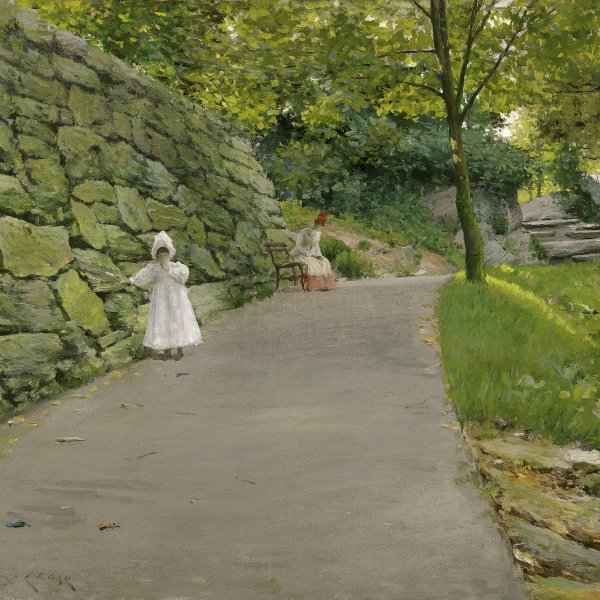Capri
1890
Oil on canvas.
44.5 x 53.3 cm
Carmen Thyssen Collection
Inv. no. (
CTB.1979.47
)
ROOM E
Level 0
Carmen Thyssen Collection and Temporary exhibition rooms
Robinson lived at Giverny in the shadow of his good friend Monet from 1888 to 1893. Though he never considered himself a student of the Impressionists, in 1890 Robinson was a recent convert to Monet's aesthetic. Not only did he take to heart Monet's theoretical admonitions and his requirement to portray the beauties and mystery of nature in a manner stringently truthful to one's personal vision, but he also studied works that were available to him in "The Master's" studio. At one time Robinson even made a pochade of one of Monet's Bordighera landscapes of 1884 as a "souvenir of tone." The Impressionist themes of modernity were of no interest to Robinson. Instead, he invariably focused on the provincial landscapes of Europe and the United States in which time had seemed to stand still.
Capri was probably inspired by Monet's paintings of the cliffs at Varengeville, Pourville, and Entretat and of the rocks at Belle-Île of the early 1880s. In these compositions Monet wrestled with the same pictorial problem as that which engrossed Robinson here: the tension between surface design and spatial illusion. One of three known paintings Robinson executed of the Italian island in 1890, Capri indicates his awareness of the decorative possibilities in the design of the landscape, even while he maintained a linear perspective which he saw as true to nature. Robinson carefully observed values and constructed the landscape so that it moved back in space convincingly along the diagonal plane of the architectural structures established in the street at the lower right. The viewer's eye follows the two figures of priests there, dressed in black robes, and moves not only back into the space of the hill town, but also diagonally up the surface of the canvas to the upper left. For Robinson, the hill is also rendered as a large abstract shape that nearly covers most of the surface area of the canvas.
The desire to play with the design of the surface was one that Robinson shared not only with Monet, but also with his close friends, the American painters Julian Alden Weir and John H. Twachtman. Robinson, Weir and Twachtman were as committed to Whistler's aesthetics of abstracting from nature and designing a harmonious and simplified pictorial surface as they were to Monet's practice of seeing nature truthfully. To this end, they studied Whistler's portraits and "nocturnes", and they collected Japanese prints-the original source of such spatial innovation which they hoped would lead them to a fresh vision of nature.
Kathleen Pyne
Capri was probably inspired by Monet's paintings of the cliffs at Varengeville, Pourville, and Entretat and of the rocks at Belle-Île of the early 1880s. In these compositions Monet wrestled with the same pictorial problem as that which engrossed Robinson here: the tension between surface design and spatial illusion. One of three known paintings Robinson executed of the Italian island in 1890, Capri indicates his awareness of the decorative possibilities in the design of the landscape, even while he maintained a linear perspective which he saw as true to nature. Robinson carefully observed values and constructed the landscape so that it moved back in space convincingly along the diagonal plane of the architectural structures established in the street at the lower right. The viewer's eye follows the two figures of priests there, dressed in black robes, and moves not only back into the space of the hill town, but also diagonally up the surface of the canvas to the upper left. For Robinson, the hill is also rendered as a large abstract shape that nearly covers most of the surface area of the canvas.
The desire to play with the design of the surface was one that Robinson shared not only with Monet, but also with his close friends, the American painters Julian Alden Weir and John H. Twachtman. Robinson, Weir and Twachtman were as committed to Whistler's aesthetics of abstracting from nature and designing a harmonious and simplified pictorial surface as they were to Monet's practice of seeing nature truthfully. To this end, they studied Whistler's portraits and "nocturnes", and they collected Japanese prints-the original source of such spatial innovation which they hoped would lead them to a fresh vision of nature.
Kathleen Pyne









